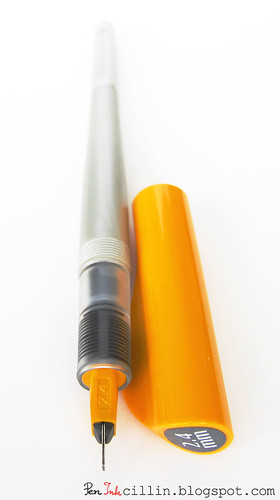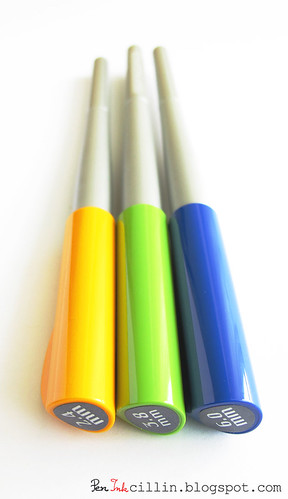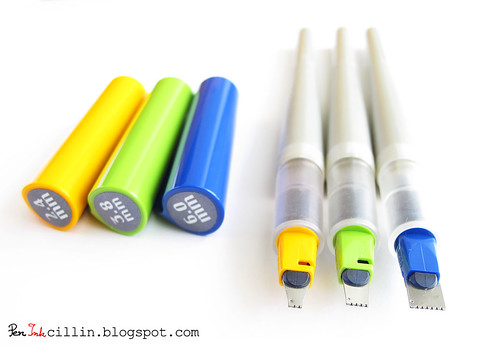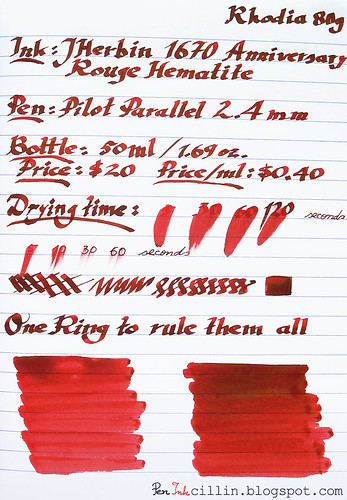Pilot has invented a rather unique concept with the Parallel series. There are currently 4 nib sizes in the series: 1.5mm, 2.4mm, 3.8mm and 6.0mm. The caps are color coded in orange, yellow, green and blue, respectively. The innovative thing about the Parallels is the nib, which is made up of two parallel plates between which the ink flows. And it flows very well.
If you look at the nib you will see how sharp the edges are. You'd be forgiven to think that the pen skips and the nib likes to grab the paper. In fact, the Pilot Parallel is very smooth on any type of paper. The sharp edges of the nib ensure that the line is sharply delimited and that there is no fuzziness at the edges.
As I write this, I have only played with the 2.4mm version but I just received the 3.8mm and the 6.0mm pens. As such, the impressions in this review pertain to my experience with the 2.4mm nib, but I'm sure the same observations are in order for the other nib sizes.
I started with the 2.4mm nib because I didn't know what to expect from these pens. After playing with it, I realized that I wanted to experience the larger nib sizes so that's why I ordered the 3.8mm and 6.0mm. I won't be getting a 1.5mm pen because I already have a 1.5mm nib for my Lamy AL-Star and the line width is about the same, although the Lamy nib is not as crisp.
One thing that beginners (myself included) might not realize is that the Pilot Parallel can be used in two ways: you can draw with the entire width of the nib or you can just use the edge (one of the sharp corners) which creates a thin line, comparable to a classic medium or fine nib.

You have seen samples of how a 2.4mm Parallel writes in my reviews of J Herbin 1670 Rouge Hematite and Noodler's Yellow as well as my Noodler's Yellow and Navajo Turquoise ink mix. I have tried my hand at some pseudo-calligraphy in fonts of my own devising but you can probably tell I'm a big noob at this sort of thing. Nonetheless, this is a fun pen to play with.
The Pilot Parallel could very well be the gateway drug into calligraphy because it is cheap (I got mine for $10), simple to operate and well-built.
There's some interesting stuff that comes in the box: the pen itself, two ink cartridges (red and black), a cleaning pump, a shim for cleaning between the plates and instructions on how to use the pen and how to get started in several calligraphy styles. There's plenty of value for only $10.
The Pilot Parallel was not designed to be carried in a shirt pocket. There is no clip on the screw-on cap, except for the fin which prevents the pen from rolling off your desk. I really like the way they did the cap: it's brightly colored, big and screws on and off very easily.
The barrel is made from a soft, silvery plastic which seems to be the only weak link in this pen. It looks rather cheap but personally I prefer soft plastic to the hard, brittle variety. One cool thing about the Parallel is that it can be easily converted to an eyedropper if you apply a little silicon grease to the threads. The barrel is airtight but since it isn't transparent, I decided not to convert mine.
The Pilot Parallel takes Pilot's proprietary cartridges but that's not a bad thing because these cartridges are huge. I like to save mine, wash them and then refill them with the ink of my choice. One little documented fact is that you can also use Pilot's CON-50 converter in the Parallel if you so choose.
The pen comes with a converter-like pump which resembles a CON-20 converter but don't be deceived: it is not a converter. In fact it is meant to be used for cleaning the pen: to pump water in and out of it. Although some people have used this pump successfully as a converter, others have reported that it is very loose and won't stay attached. Mine, for example, is extremely loose.
Thing is, you don't even need to use the pump to clean the pen. What I love about it is that you can easily take the pen apart for cleaning. First, the feed is friction-fitted to the section. It slides out easily.
Second, the nib (actually the two plates) can be grabbed and pulled out of the section. Here's how the plates look when pulled. The plates are much tighter than the feed, though, so I used a piece of cloth to grab them with.
I just love a fountain pen that can be taken apart easily. That's the best way to ensure that there's no gunk left after cleaning.
As mentioned before, I like to refill used cartridges with whatever ink I fancy, and I do that with a syringe. It's the least messy and cheapest way to fill up these pens. As a rule, I don't like to make eyedroppers out of opaque pens. I like to see the ink level and besides I'm always scared that the barrel might come unscrewed and spill all that ink over me.
I'd like to mention one final thing about the 6.0mm Parallel. Many people have been using it as a highlighter. At 6mm, the line is very wide and can easily cover any handwritten text. If you can also load the pen with a special highlighting ink, you are bound to have endless fun highlighting stuff. Just a warning though: this could become addictive!
I would highly recommend the Pilot Parallel pens to anyone interested in calligraphy. As to what size is the best, that's a hard question. I started with the 2.4mm because I considered it intermediary. You might want to start with the 1.5mm or with the wider nibs. Either way, before long you will probably end up craving the other sizes that you are missing.
Here are samples from my previous ink reviews using the Pilot Parallel 2.4mm.














Wow, those are really cool! I've been looking at these fro a little while now but was waiting for a decent review of them. Thanks for this one. :)
ReplyDeleteIt makes those inks look great, especially the J. Herbin one!
Regards,
777 - Tyler Dahl
Yeah it really brings out the shading in inks that have it. J Herbin 1670 looks ordinary in a normal pen but it shines in the Parallel. You should definitely get at least one of these. It's a lot of fun to play with.
ReplyDeleteHmm... Stop making me want to spend money... :)
ReplyDeleteI will definitely end up trying one of these... They look like a lot of fun!
Regards,
777
Well, you're the big spender, Mr M805 :) What's $10 extra?
ReplyDeleteWell... :)
ReplyDeleteAfter spending so much on one pen I need a break for a while. It's kind of a traumatizing experience... :|
The only thing that makes it worth it is of course, the pen!
Regards,
777 - Tyler Dahl :)
Great review--wonderful pictures. You make my blog look really clumsy. Thanks for passing by!
ReplyDeleteCheers,
Bruno Taut
Great review of a great line of pens. These things are awesome! I really like how you showed how the pen disassembles, too. Thanks for that.
ReplyDeleteThanks Brian, glad you liked it! I almost didn't manage to show the nib removed from the feed because I couldn't pull it out. Until it did, unexpectedly.
ReplyDeleteGreat review :D I've been too lazy to do a real review, I just like to use them as you know ;) I like that you can pull out the nib section. It makes it easy to clean! I've had mine for about three years now and they have held up really well.
ReplyDeleteThanks! You didn't know that you can remove the nib? I didn't know either at the beginning but then someone mentioned it somewhere on a blog. Yeah, I don't see these pens failing, the construction is too simple and straightforward for that to happen.
ReplyDeleteI knew you could disassemble it. I figured it out very early on :) . Made cleaning really easy :D Sorry if I was unclear in the previous comment. A lot of people like them because you can use any ink in them and not worry about clogging. I've read some people have used acrylic inks in theirs like Daler Rowney FW inks.
ReplyDeleteThanks for the great review! I just got a couple of these for my birthday (1.5mm and 2.4 mm) and was curious if I could use the converter as a converter instead of just for cleaning. Now I know to stick with the cartridges until I can pick up a CON-50 or two. It's gonna be tough because I really want to try Noodler's Black Swan in Australian Roses and Black Swan in English Roses in these, but I suppose I can learn to be patient. ;)
ReplyDeleteThanks Andi! I can offer you a couple of other options:
ReplyDelete1) fill empty cartridges with a syringe
2) convert the pen to an eyedropper
In my opinion the converter is a bit expensive compared to the price of the pen.
Actually, I found that with a gentle push the CON-20 fit very securely in mine, so I gave it a go with the Australian Roses. Worked fine.
ReplyDeleteI'll probably still pick up a couple of CON-50s, though. I've got other pens they would work in, and since I'm not a fan of cartridges it wouldn't hurt to have them around.
Thanks again!
hi, i am newcomer to calligraphy, and i have bought one of these pens. 2.4 mm .
ReplyDeleteMy silly question is; when do you have to clean the pen.?
Is it ok to use the cap after every use.
I've used to pen only twice and when i removed the cap, it took a long time to get the ink flowing..........
With a fountain pen it's VERY indicated to replace the cap after using it. Otherwise the ink will just dry out. You might risk clogging the mechanism badly, especially with more stubborn inks.
ReplyDeleteIn general pens should be cleaned when changing inks but also at least once or twice a year even if you keep using the same ink, to prevent deposits from forming inside.
Thanks for this excellent review! As an instructional designer and also a person who needs/wants this information, i am very impressed. The pens are required for a Travel Sketching class I was thinking of taking at my local community college. Your review with its very clear instructions and photos made me decide to take the class. I am very intrigued with the pen. We aren't using it for calligraphy though. We are using it for sketching and will be drawing out the ink. I've never sketched like this before so It should be an interesting and fun challenge. I'll check back in with my results, if you like.
ReplyDeleteGlad I could help! By all means, share your result, I'd be happy to see them. I love these pens because they're cheap, yet excellent for their intended use. In fact, like you discovered, there's more than calligraphy to them. The 6mm is great to use as a highlighter, with appropriate ink, of course.
ReplyDeleteOf course they will. There's nothing special about bulletproof inks that would prevent them from working with certain types of fountain pens. However I have noticed that some waterproof/bulletproof inks tend to be harder to clean and they might even stain the pen. That won't be an issue if you stick to the same ink in a certain pen.
ReplyDeleteOne question that I have for you is how will you fill the pen? Will you use a recycled cartridge? Or will you do an eyedropper conversion? I would suggest the latter, though I haven't tried it myself.
would you suggest 3.8 or 6 mm ?
ReplyDeleteI would suggest all of them, to be honest. They're not that expensive. But if you were to pick one, it depends what your intentions are. The 6mm, for example, can be excellent with highlighter ink, so you could use it in place of a felt-tip highlighter.
ReplyDelete